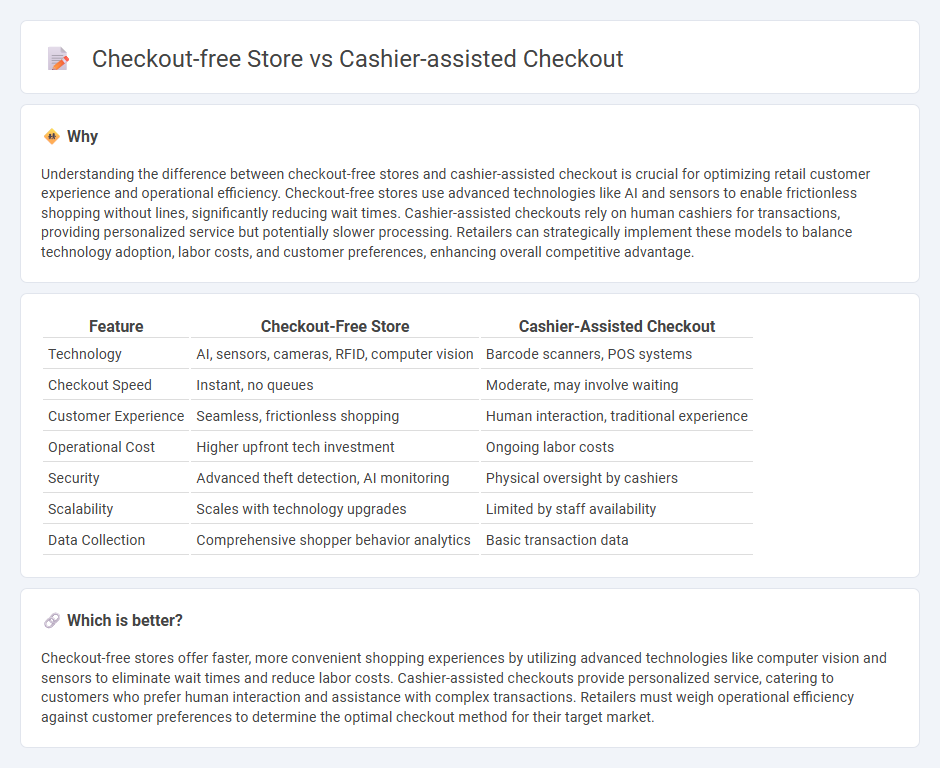
Checkout-free stores utilize advanced technologies like RFID, computer vision, and AI to enable seamless, automated purchasing without traditional cashier interaction, significantly reducing queue times and enhancing customer convenience. Cashier-assisted checkouts rely on human staff to scan and process transactions, providing personalized service but often resulting in longer wait times during peak hours. Explore the evolving landscape of retail checkout innovations to understand which system best suits modern consumer needs.
Why it is important
Understanding the difference between checkout-free stores and cashier-assisted checkout is crucial for optimizing retail customer experience and operational efficiency. Checkout-free stores use advanced technologies like AI and sensors to enable frictionless shopping without lines, significantly reducing wait times. Cashier-assisted checkouts rely on human cashiers for transactions, providing personalized service but potentially slower processing. Retailers can strategically implement these models to balance technology adoption, labor costs, and customer preferences, enhancing overall competitive advantage.
Comparison Table
| Feature | Checkout-Free Store | Cashier-Assisted Checkout |
|---|---|---|
| Technology | AI, sensors, cameras, RFID, computer vision | Barcode scanners, POS systems |
| Checkout Speed | Instant, no queues | Moderate, may involve waiting |
| Customer Experience | Seamless, frictionless shopping | Human interaction, traditional experience |
| Operational Cost | Higher upfront tech investment | Ongoing labor costs |
| Security | Advanced theft detection, AI monitoring | Physical oversight by cashiers |
| Scalability | Scales with technology upgrades | Limited by staff availability |
| Data Collection | Comprehensive shopper behavior analytics | Basic transaction data |
Which is better?
Checkout-free stores offer faster, more convenient shopping experiences by utilizing advanced technologies like computer vision and sensors to eliminate wait times and reduce labor costs. Cashier-assisted checkouts provide personalized service, catering to customers who prefer human interaction and assistance with complex transactions. Retailers must weigh operational efficiency against customer preferences to determine the optimal checkout method for their target market.
Connection
Checkout-free stores utilize advanced sensors, AI, and computer vision to enable customers to shop and leave without stopping at a cashier, enhancing convenience and reducing wait times. Cashier-assisted checkout complements this by providing a human-operated option for customers preferring personalized assistance or handling complex transactions, ensuring inclusivity. Together, these systems create a flexible retail environment that balances automation with human interaction to optimize the shopping experience.
Key Terms
Point of Sale (POS)
Cashier-assisted checkout relies on human-operated Point of Sale (POS) systems, enabling personalized customer service and handling complex transactions efficiently. Checkout-free stores use advanced POS technology integrated with sensors and computer vision to automatically track purchases without manual scanning, enhancing speed and convenience. Explore the latest POS innovations to understand how both models reshape retail experiences.
Computer Vision
Cashier-assisted checkout leverages computer vision to assist cashiers by scanning items and verifying purchases, enhancing accuracy and reducing human error in traditional retail environments. Checkout-free stores rely heavily on advanced computer vision algorithms and sensor fusion to enable seamless, contactless shopping experiences by automatically detecting and billing items in real-time. Explore the latest innovations in computer vision shaping the future of retail efficiency and customer convenience.
RFID (Radio-Frequency Identification)
RFID technology enhances cashier-assisted checkout by speeding up item scanning and reducing manual errors, improving transaction efficiency and inventory accuracy. In checkout-free stores, RFID enables seamless, automatic tracking of products without traditional checkout processes, providing a frictionless shopping experience and real-time inventory updates. Explore how RFID revolutionizes retail operations in both models to optimize customer convenience and operational efficiency.
Source and External Links
Assisted Checkout Boosts Customer Satisfaction | RadiusAI, Inc - Cashier-assisted checkout systems like ShopAssist use computer vision to rapidly scan all items at once, allowing customers to unload their goods on the counter while the cashier supports certain tasks such as coupon use or ID checks, thus merging speed with traditional personal service to enhance customer experience.
Flex Check Out | Self-Checkout and Cashier Register POS - Creslane - CresLane's Flex Check Out software enables stores to seamlessly switch between cashier-assisted and self-service checkout modes, supporting multiple payment methods and optimizing both customer convenience and store operations.
Self Checkout | IT Retail Point of Sale - ITRetail - Self-checkout systems enhance convenience and speed by allowing customers to scan and pay independently, yet can also be configured for cashier-assisted mode to tailor service and improve efficiency, helping stores process more transactions with less staff.
 dowidth.com
dowidth.com